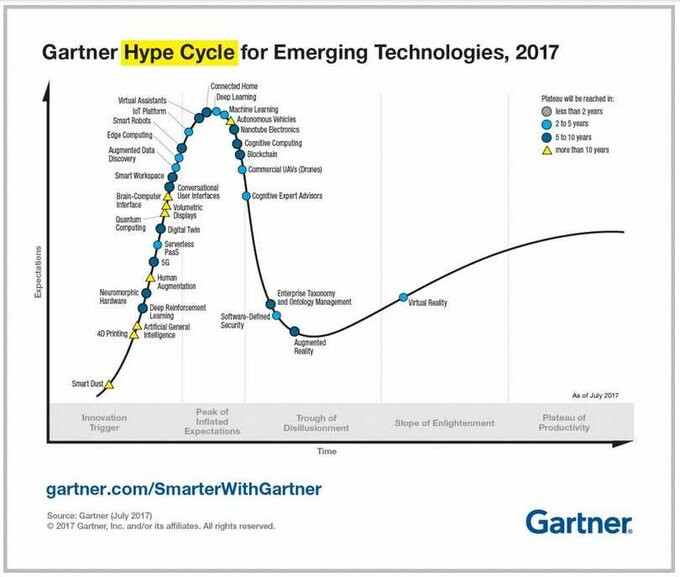
This phenomenon mainly occurs in industries where one innovations quickly follow another, such as IT. A few years ago, all software vendors and consultancy firms claimed topics like big data and bring your own device; now, blockchain, Internet of Things and artificial intelligence are all the rage.
In knowledge-intensive industries like tech, claiming expertise is an important part of any PR and content strategy. You offer a little knowledge, with the aim of being seen as an authority in your field.
Making Choices and Distinguishing Yourself
How do you become and remain an expert in such a dynamic market? There are two important steps: you start by making choices, and then finding your unique voice. Perhaps as a company you want to talk about all new developments. Don’t hop on every bandwagon. Ask yourself: which trend or development really offers a business opportunity to us – in other words, which ones do we focus on? It’s all about choices; remember that your target audience does not have enough space to associate your organization with five or seven topics. Two or three at most and that’s still a lot.
The search for the distinctive hook is even more complicated. If hundreds (or thousands) of experts have already written a paper about the advance of robotization and its consequences for the workforce, try to add something original to it.
Being distinctive is, of course, an important part of creativity and making bold moves. The way you can distinguish yourself depends greatly on which phase the hype is in. The theory of the hypecycle is a good peg to determine your PR strategy.
Hypes Follow Cycles
The theory of the hypecycle says that trends often go through a similar development. Gartner, a renowned analyst firm, has developed a framework for this.

- Innovation trigger: this is when a technology is new and the first experts start writing about it. The early adopters experiment with it. Quantum computers are now in this phase. The promise beckons, but it is not all that specific yet – let alone that quantum computers are already available in the store.
- The Peak of inflated expectations: is the phase in which, as the word already says, expectations are high. Internet of Things and machine learning are now in this peak. Experts tumble over each other to claim expertise.
- Which automatically leads to the trough of disillusionment : the market is a bit done with it. People start questioning a trend, or even try to pull it out. Blockchain is now at the beginning of this phase. Where the technology was first praised by most experts, now people are starting to doubt its market potential.
- Usually hypes climb up again into the slope of enlightenment. This is the moment when real money is slowly being earned with a technology. We have passed the phase of skepticism and are now seeing commercial applications: virtual reality is currently in this phase.
- Hypes that survive phases 1 through 4 ultimately end up on the plateau of productivity . Cloud computing is a typical technology that has already been through all of the early phases of the hype cycle and is now mature. Few IT experts doubt the commercial viability of cloud computing. It’s a mature market, which is still growing, but steadily.
Each Phase has its Own PR Strategy
The hype phases are, as mentioned, an excellent basis for determining your PR and content strategy.

Innovation Trigger: Inform
Is a technology at the beginning of the hypecycle? Then it is mainly a matter of showing expertise by informing your audience. You can explain what the technology entails and what benefits it offers through blogs, whitepapers or in media interviews. This mainly concerns charging the awareness. Convince your readers that this technology is going to be important and what you can do with it.
Peak of Inflated Expectations: Distinguish
In the peak of the hypecycle, it is especially important to have a unique sound. Many experts will try and enter the thought leadership realm and as an expert you have to distinguish yourself from the rest. It also helps if you were already actively working on the subject in phase one, because then you have already built up a certain amount of expertise. In doing so, do not fall into the trap of letting go of a subject because multiple parties are going to infiltrate your subject. This is the time to stand your ground; don’t let go of your thought leadership position, but continue claiming your topic.
Trough of Disillusionment: Practical Tips
If the hype has passed its peak, in the trough or disillusionment, you will notice that there is vivid discussion about the (commercial) usefulness of a technology. More experts are talking about a hype than actually putting the technology into practice. Here is your chance. Share practical tips, the first commercial success stories and tricks on how to make a technology work for your organization.
Slope of Enlightenment: Reference Cases
That certainly applies to the phase of the slope of enlightenment: we have already passed the low point of the dip. The early majority will now seriously consider using a technology, but is still looking for examples of other organizations that apply it successfully. In your communication strategy, this is the time to share user cases, for example in the form of reference articles or case study videos.
Plateau of Productivity: Success Stories
When the plateau of productivity is reached, you will find that of the many players in the market. As a result, the margins have probably shrunk slightly, because the technology has become commonplace. Therefore, don’t spend too much time explaining for a long time why companies have to work with a technology. They probably already know. But success stories will still perform well. Certainly in a market like IT, where the investments are good and the sales cycles are long, your prospects will do extensive research before they start working with a supplier or consultant. It helps to demonstrate that you have expertise in and experience with this technology.
Unique Sound
The question remains of course how you distinguish yourself from the rest when a hype is at its peak. That is partly a matter of creativity and being daring, but that is certainly not everything.
If you want to be unique, you first have to know what is not unique. There are many excellent tools available that can map which players dominate the (online) discussions and which key messages they tend to use. So do not go off of your gut feeling, but perform research on data in social or traditional media data to find out which messages your target audience has claimed already. This is the moment where creativity comes in – to claim your unique spot in that discussion.
In short: even if you are in a turbulent, innovative market, there are ways to determine and fine-tune your PR and content strategy. Pick the topics that you really want to focus on, then consider where this subject is in the hypecycle and finally determine your unique sound. You can go with a little gut feeling, but data will take you further than you might think.
To learn how LEWIS can help you navigate hype cycles, view our services!



